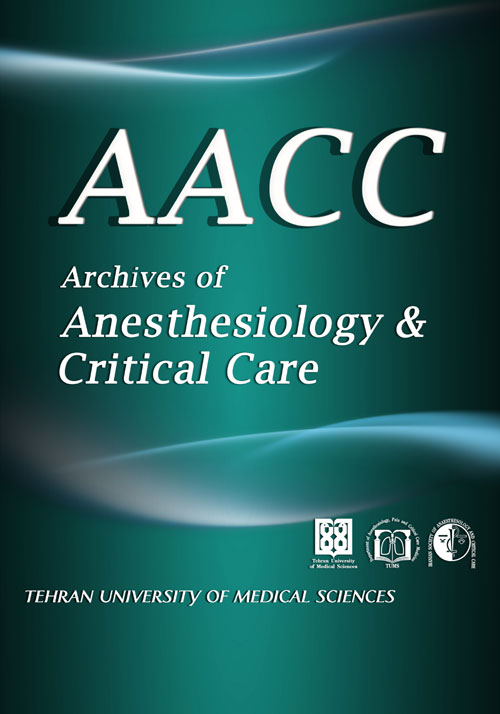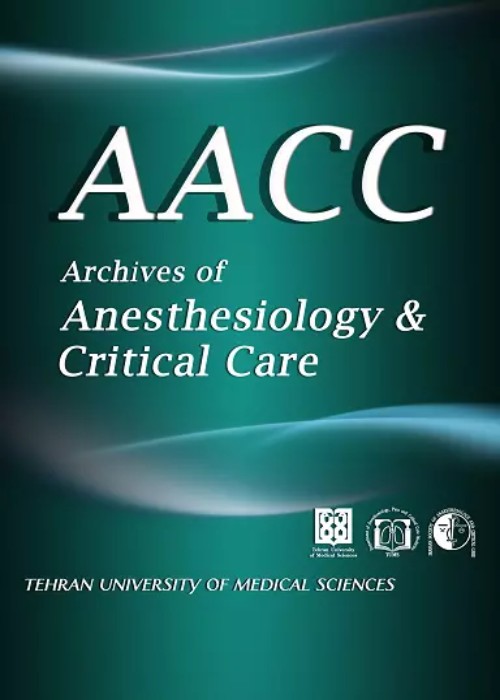فهرست مطالب

Archives of Anesthesiology and Critical Care
Volume:1 Issue: 3, Summer 2015
- تاریخ انتشار: 1394/07/04
- تعداد عناوین: 9
-
-
Pages 65-66
-
Pages 67-71BackgroundAlthough laparoscopic cholecystectomy is associated with less post-operative pain compared to open cholecystectomy, diffuse shoulder and abdominal pain is one of the main postoperative complications in this technique. The aim of this study was to compare the abdominal and shoulder pain after laparoscopic cholecystectomy by applying intra-abdominal bupivacaine instillation versus the trendelenburg position and valsalva maneuver.MethodsA double blind randomized clinical trial was conducted in the university hospital. 120 patients aged 25-55 years were scheduled for elective laparoscopic cholecystectomy and without any history of previous surgery, pregnancy or acute abdomen were enrolled. Patients were allocated into 4 groups (each30 cases)Group 1 received just intra-peritoneal normal saline (NS). Group 2 patients who were placed intrendelenburg position plus valsalva maneuver and received intra-peritoneal NS. For group 3, intra- peritoneal bupivacaine instillation was done. Patients in group 4 received intra-peritoneal bupivacaine as well as were placed in trendelenburg position plus valsalva maneuver. Post-operative pain severity using visual analog scale, analgesic requirement and nausea and vomiting were recorded in all patients.ResultsTotal mean pain score at 24 hours was 3.55±0.47 in group 1, 1.08 ±0.85 in group 2, 0.33 ±0.14 in group 3, and 0.20 ±0.59 in group 4 (P= 0.001). Mean total score of shoulder pain was 4.70 ±2.18 in group1, 1.23 ±0.11 in group 2, 1.18 ±0.11 in group 3, and 0.70 ±0.12 in group 4 (P= 0.001).ConclusionCombined intra-peritoneal bupivacaine with trendelenburg positioning and valsalva maneuver was superior to either one alone in decreasing pain severity after laparoscopic cholecystectomy.Keywords: laparoscopic cholecystectomy, pain, trendelenburg position, valsalva maneuver
-
Pages 72-75BackgroundThere is evidence that electrocardiographic (ECG) changes occur during elective cesarean section in parturients. These changes, mostly in the form of ST-segment depression, have been noted in either regional anesthesia or general anesthesia. We performed this study to compare hemodynamic variables and electrocardiographic changes suggestive of myocardial ischemia following administration of oxytocin in elective cesarean delivery between regional and general anesthesia methods.MethodsIn this double-blinded randomized clinical trial, 130 parturients were randomly divided into two groups of general anesthesia (65 cases) and spinal anesthesia (65 cases). After delivery of the baby and placenta, firstly a bolus of 5 units of oxytocin was injected, and then 30 units of oxytocin was infused over 30 minutes in both groups. Hemodynamic variables including heart rate (HR), systolic blood pressure (SBP) and diastolic blood pressure (DBP) were studied. ECG recording was done twice (1 hour and 24 hour) after the operation. For those who demonstrated ECG changes, serum troponin I level was measured.ResultsThe ECG changes suggestive of ischemia was higher in general anesthesia group (36.9%, 24 cases) compared to spinal anesthesia group (24.6%, 16 cases), but it was not statistically significant (P= 0.12). Troponin I levels checked for patients with ECG changes were all within normal limits.ConclusionAlthough ST depression on ECG was more prevalent in parturients who underwent cesarean section under general anesthesia compared to spinal anesthesia, the difference was not statistically significant. None of the cases demonstrated myocardial injury based on Troponin I measurements.Keywords: electrocardiography, cesarean section, oxytocin, myocardial ischemia, general anesthesia, spinal anesthesia
-
Pages 76-79BackgroundWe administered paracetamol and fentanyl at the beginning of phacoemulsification cataract surgery. We think that paracetamol administered alone is as effective as fentanyl in treating pain after cataract surgery with fewer side effects during operation and in post anesthesia care unit (PACU). The goal of this study was to compare to the postoperative pain relief effect of paracetamol and fentanyl and to assess their side effects in PACU.MethodsThis study was a randomized double-blinded clinical trial comprising 160 patients aged 50-80 year old undergoing cataract surgery using phacoemulsification method by local anesthesia and sedation. The patients were randomized to two groups; patients who received 1 gr paracetamol (P group) and who received 1µg/kg fentanyl (F group) at the beginning of operation. The pain, sedation, patients’ satisfaction and complications during surgery and recovery time were assessed.ResultsThe mean scores for intraoperative and postoperative pain on the visual analog scale showed no statistically significant differences (P=0.445). The scores of anxiety and pain were not significantly different comparing two groups after the surgery (P =0.574). The mean score of satisfaction was (8.84± 1.096) in P group and (9.48 ± 8.03) in F group (p=0.04). The mean arterial blood pressure in group P was lower comparing with group F (P=0.011). Nausea and vomiting, apnea and arrhythmia did not occur in P group, while 3(3.8%) of patients in group F had apnea and arrhythmia, 4(5%) had nausea, and 3(3.8%) had vomiting. While these differences were clinically significant, only nausea showed statistically significant difference between two groups (P=0.043).ConclusionParacetamol is an effective analgesic for postsurgical pain in patients undergoing cataract surgery and it is safe with no important side effects.Keywords: paracetamol, fentanyl, Phacoemulsification, pain
-
Pages 80-83BackgroundChloral hydrate (CH) is a sedative agent that is widely used in infants and children for several decades. The purpose of this study was to evaluate the safety and efficacy of CH before general anesthesia in pediatric population undergoing eye examination.Methods165 pediatric patients with retinal tumor were examined from December 2014 to May 2015. 158 (95.7%) children were sedated by CH before general anesthesia. CH was used at a dose of 25 mg/kg with an augmentation dose, if necessary, in 20-30 minutes. We recorded the safety of CH, the success or fail of sedation, augmentation CH dose, time to sedation and complications of CH administration.ResultsIn our study 158 (95.7%) children were sedated by CH and sixty four (40.5%) of these patients were under one year of age and ninety four (59.5%) were older. Successful sedation was achieved in 150/158 (94.9%) of the children. The success rate of sedation was higher in children below 1 year of age (63/64; 98.4%) compared to subjects older than 1 year (88/94; 93.6%) (P=0.01). The mean of time to sedation was 20.8±12.4 and 22.4±14.8 minutes in children below 1 year of age and older than 1 year respectively (p=0.91). Complications were observed in 4/158 (2.5%) of the children. We observed no episodes of desaturation after administration of CH in all subjects.ConclusionCH is a safe and effective sedative agent for children before general anesthesia provided it is used in a hospital setting with appropriately trained staff.Keywords: chloral hydrate, pediatrics, sedation, general anesthesia
-
Pages 84-87BackgroundAcute normovolemic hemodilution is an available technique to decrease the side effects of allogenic blood transfusion. The aim of this study was to compare acute normovolemic hemodilution with allogenic blood transfusion in adult patients who were scheduled for femoral fracture surgery.MethodsIn this randomized controlled trial, 50 patients were randomly allocated into two equal groups. General anesthesia was induced in all patients. After induction of anesthesia in case group (n=25) 500 ml blood was taken from patients, while the circulating blood volume was restored by ringer solution (3ml ringer for each 1ml of blood withdrawn). The blood extracted was re-infused during or after surgery according to the patient''s hemoglobin and hemodynamic parameters. In case there was further need for blood, allogenic blood was transfused. In the control group (n=25), only allogenic blood was transfused according to estimated patient’s blood loss. Patients'' assessment was performed by an anesthesiologist who was blinded to the patients'' allocation.ResultsDemographic and laboratory data were similar between both groups. Pre- and postoperative laboratory tests were similar in both groups except in mean platelet count (p=0.001). The patients in the two groups were comparable regarding hemodynamic parameters. In the control group, 11 patients needed allogenic blood transfusion and in the case group, allogenic blood was transfused in 4 patients (p=0.03).ConclusionThis study suggested that acute normovolemic hemodilution autotransfusion reduced allogenic blood transfusion in patients who underwent femoral fracture surgery.Keywords: allogenic blood transfusion, autologous blood transfusion, hemodilution
-
Pages 88-98While for a long time it has been perceived that neonates and young children do not perceive pain as the adult, this notion had to be corrected on the basis of neurophysiological data and the ontogenisis of the nociceptive system. Also, it has been demonstrated conclusively that neonates and the young infant perceive pain at a much lower nociceptive input which is largely due to a still immature inhibitory descending neuronal pathway. Minor inflictions are threfore perceived as a strong painful input, resulting in a greater size of the receptive field, long lasting pain sensations at high intensity, all which may have an impact on a lowering of the pain threshold, a change of behavioral patterns and a lesser performance at school at later life.Pain as being induced during surgery makes administration of potent opioids mandatory. One, however, has to take into consideration that because of the immature development of the opioid subreceptor system, before reaching a max. analgsic level, respiratory depression and muscular rigidity become apparent. In addition, because of the immaturity of liver enzymes, the age-related rapid change in the volume of distribution and the elimination half-life, the duration action of an opioid cannot be predicted. It is therefore is advisable to titrate the dose to effect and not on a mg/kg-basis.Keywords: Neonate, descending inhibitory noceptive system, ontogenisis opioid, subreceptors, tolerance development, type of opioid
-
Pages 99-100This case report describes an unusual spectrum of a proved anaphylactoid reaction to vancomycin during general anesthesia for release of tethered spinal cord in a 14 year old girl. Bronchospasm which is the sine qua non of a classical anaphylactoid reaction was singularly absent in this particular case. Our objective in this presentation is to highlight the importance of early recognition of this potentially fatal drug reaction which should be taken into consideration in the absence of bronchospasm if other clinical signs are subtle and unequivocal.Keywords: Anaphylactoid reaction, Anesthesia, Bronchospasm, Vancomycin


